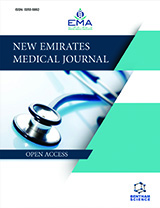Abstract
Background: Dermatoglyphics is the study of dermal ridge configuration on the skin of the fingers and palms, which can be used to diagnose chromosomal disorders and individual identification. Stress is characterized by feeling overwhelmed with mental or emotional pressure and evokes a biological response when any intrinsic or extrinsic stimulus is applied. Stress can cause acute effects and disorders that can trigger structural changes like atrophy and decrement in weight in different brain parts with long-term effects on the nervous system.
Materials and Methods: In this cross-sectional study, fingerprints of 150 participants of Gulf Medical University with an equal number of students and faculty/ staff were obtained by fingerprint scanner. Participants were classified into low, moderate, and high-stress levels by questionnaire. Collected data were statistically analyzed to find any association between dermatoglyphics and perceived stress levels.
Results: Radial Loop was found to have the highest frequency as a percentage in all three groups. Plain whorl was the pattern with the second-highest percentage of occurrences. A notable observation was the lack of plain arch and low frequency of accidental whorl in the high-stress group.
Conclusion: The findings contribute to our understanding of the potential of dermatoglyphics as an indicator of perceived stress, opening up avenues for further research in utilizing these patterns as a non-invasive tool for assessing stress levels.
New Emirates Medical Journal
Title:A Study of Dermatoglyphics Patterns in Relation to the Levels of Perceived Stress
Volume: 5
Author(s): Isra Ishtiaq Shakir, Sadaf Sheikhi, Marwa Mahmood, Naba Khan, Ramya Rathan*Miral Salama
Affiliation:
- College of Medicine, Gulf Medical University, Ajman, UAE
Abstract:
Background: Dermatoglyphics is the study of dermal ridge configuration on the skin of the fingers and palms, which can be used to diagnose chromosomal disorders and individual identification. Stress is characterized by feeling overwhelmed with mental or emotional pressure and evokes a biological response when any intrinsic or extrinsic stimulus is applied. Stress can cause acute effects and disorders that can trigger structural changes like atrophy and decrement in weight in different brain parts with long-term effects on the nervous system.
Materials and Methods: In this cross-sectional study, fingerprints of 150 participants of Gulf Medical University with an equal number of students and faculty/ staff were obtained by fingerprint scanner. Participants were classified into low, moderate, and high-stress levels by questionnaire. Collected data were statistically analyzed to find any association between dermatoglyphics and perceived stress levels.
Results: Radial Loop was found to have the highest frequency as a percentage in all three groups. Plain whorl was the pattern with the second-highest percentage of occurrences. A notable observation was the lack of plain arch and low frequency of accidental whorl in the high-stress group.
Conclusion: The findings contribute to our understanding of the potential of dermatoglyphics as an indicator of perceived stress, opening up avenues for further research in utilizing these patterns as a non-invasive tool for assessing stress levels.
Export Options
About this article
Cite this article as:
Shakir Isra Ishtiaq, Sheikhi Sadaf, Mahmood Marwa, Khan Naba, Rathan Ramya*, Salama Miral, A Study of Dermatoglyphics Patterns in Relation to the Levels of Perceived Stress, New Emirates Medical Journal 2024; 5 : e02506882292950 . https://dx.doi.org/10.2174/0102506882292950240324031617
| DOI https://dx.doi.org/10.2174/0102506882292950240324031617 |
Print ISSN 0250-6882 |
| Publisher Name Bentham Science Publisher |
Online ISSN 0250-6882 |

- Author Guidelines
- Bentham Author Support Services (BASS)
- Graphical Abstracts
- Fabricating and Stating False Information
- Research Misconduct
- Post Publication Discussions and Corrections
- Publishing Ethics and Rectitude
- Increase Visibility of Your Article
- Archiving Policies
- Peer Review Workflow
- Order Your Article Before Print
- Promote Your Article
- Manuscript Transfer Facility
- Editorial Policies
- Allegations from Whistleblowers




























